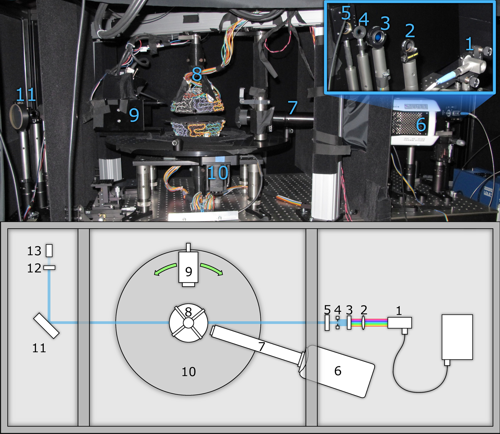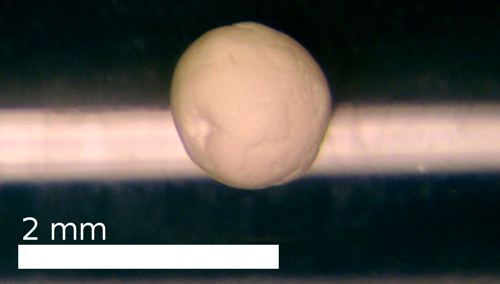Scatterometer-levitator for light-scattering measurements with full control on particle position and orientation
- 1University of Helsinki, Department of Physics, Helsinki, Finland (karri.muinonen@helsinki.fi)
- 2National Land Survey, Finnish Geospatial Research Institute FGI, Masala, Finland
Abstract. The optical properties of a sample are important in, e.g., astrophysics and space science. The samples can be unique or available in limited quantities, implying that sample preservation is important. Established single-particle light-scattering measurements involve attaching the sample to a holder or measuring a laminar flow of particles, neither of which allows for a controlled and non-destructive measurement. Acoustic levitation is a state-of-the-art approach applicable to scattering measurements. We present an instrument capable of performing a full 4π scattering measurement, i.e., a measurement from any direction on the full 4π solid angle. We measure scattering properties of millimeter-sized samples at any direction. This is enabled by introducing a novel non-contacting sample holder based on acoustic levitation, which allows a disturbance-free measurement of an orientation-controlled sample. The instrument is scalable and currently employs polarized visible light (400–700 nm). It also measures beam and sample stability as well as temperature and humidity, to ensure consistency of measurements. We demonstrate a measurement of a sample consisting of agglomerated 500-nm silica spheres. The upper left 2×2 submatrix of the Mueller scattering matrix is measured from the sample along the scattering angle.
1. Introduction
Experimental measurements of light scattering by a small-particle sample in a controlled position and orientation (six degrees of freedom) has remained open. Scattering characteristics for single particles have been earlier measured as ensemble averages over the size, shape, and orientation distribution (e.g., [1]) by introducing a particle flow through the measurement volume. Scattering characteristics for single particles in levitation have been carried out using, for example, electrodynamic levitation [2] and optical tweezers [3-5]. In the present manuscript, a novel experimental method based on ultrasonic levitation with full control of the sample position and orientation is offered [6-8].
2. Levitator-scatterometer: results and discussion
Figure 1 shows our levitator scatterometer with detailed information about its components.

Figure 1: Levitator-scatterometer with a photograph (above) and top view schematic (below). The components are as follows: (1) fiber-coupled light source with collimator, (2) focusing lens (optional), (3) bandpass filter for wavelength selection, (4) adjustable aperture for beam shaping, (5) motorized linear polarizer, (6) high-speed camera, (7) high-magnification objective, (8) acoustic levitator for sample trapping, (9) measurement head, comprising an IR filter, motorized shutter, motorized linear polarizer, and a photomultiplier tube (PMT), (10) motorized rotation stage for adjusting measurement head angle, (11) optical flat for Fresnel reflection, (12) neutral density filter, and (13) reference PMT, for monitoring beam intensity. The system is divided into three enclosed compartments to eliminate stray light.
For the experiment, an aggregate consisting of densely-packed, nominally 0.5-µm diameter spherical SiO2 particles was selected and polished further, to approximate a spherical shape, after which it was characterized by weighing and measuring its dimensions (Fig. 2). The nearly spherical aggregate had a diameter of 1.16 mm and a volume density of 0.47. The light beam was filtered to 488±5 nm, with a Gaussian spectrum. The measured phase function, degree of linear polarization for unpolarized incident light, as well as the depolarization are shown in Figs. 3-5, respectively, as a function of the phase angle (source-sample-detector angle).

Figure 2: The sample of densely-packed spherical SiO2 grains.
Figure 3: The measured and modeled phase functions normalized to unity when integrated from 15.1° to 165.04°.
Figure 4: Degree of linear polarization for unpolarized incident light (Mueller scattering-matrix-element ratio -M12/M11 in %) from the measuements and modeling.
Figure 5: Depolarization (M22/M11) from the measurements and modeling.
Figures 3-5 further include the first modeling based on the R2T2 and SIRIS4 software (Radiative Transfer with Reciprocal Transactions; see [6] and references therein). The phase function is accurately modeled, whereas there are challenges remaining for modeling the degree of polarization and depolarization. There is compelling need for high-precision validation samples with accurate documentation: the size and shape distributions of the silica samples remain too uncertain to be utilized in model validation.
Conclusion
We have described novel experimental instrumentation for measuring light scattering by isolated samples in levitation. As it is extremely difficult to accurately characterize random media composed of sub-wavelength-scale particles or inhomogeneities, controlled Mueller-matrix measurements can offer a tool for retrieving information on the volume density and particle size and shape distribution in the medium.
Acknowledgments. Research by KM, AP, HH, and MG supported, in part, by the Academy of Finland (grants 325805 and 325806).
References
[1] Muñoz, O., Volten, H., de Haan, J. F., Vassen, W., and Hovenier, J. W.: Experimental determination of scattering matrices of olivine and Allende meteorite particles, Astron. Astrophys., Vol. 360, pp. 777–788, 2000.
[2] Sasse, C., Muinonen, K., Piironen, J., and Dröse, G.: Albedo measurements on single particles, J. Quantitat. Spectrosc. Radiat. Transf., Vol. 55, pp. 673—681, 1996.
[3] Gong, Z., Pan, Y.-L., Videen, G., and Wang, C.: Optical trapping and manipulation of single particles in air: Principles, technical details, and applications, J. Quantitat. Spectrosc. Radiat. Transf., Vol. 214, pp. 94–119, 2018.
[4] Nieminen, T. A., du Preez-Wilkinson, N., Stilgoe, A. B., Loke, V. L. Y., Bui, A. A. M., and Rubinsztein-Dunlop, H. Optical tweezers: Theory and modelling. J. Quantitat. Spectrosc. Radiat. Transf., Vol. 146, pp. 59–80, 2014.
[5] Herranen, J., Markkanen, J., and Muinonen, K. Dynamics of interstellar dust particles in electromagnetic radiation fields: A numerical solution. Radio Sci., Vol. 52(8), pp. 1016–1029, 2017.
[6] Muinonen, K., Väisänen, T., Martikainen, J., Markkanen, J., Penttilä, A., Gritsevich, M., Peltoniemi, J., Blum, J., Herranen, J., Videen, G., Maconi, G., Helander, P., Salmi, A., Kassamakov, I., and Haeggström, E.: Scattering and absorption of light in planetary regoliths. J. Visual. Exper., Vol. 149, e59607, doi:10.3791/59607, 2019.
[7] Maconi, G., Helander, P., Gritsevich, M., Salmi, A., Penttilä, A., Kassamakov, I., Haeggström, E., and Muinonen, K.: 4π scatterometer, J. Quantitat. Spectrosc. Radiat. Transf., Vol. 246, 106910, 1-7, 2020.
[8] Helander, P., Puranen, T., Meriläinen, A., Maconi, G., Penttilä, A., Gritsevich, M., Kassamakov, I., Salmi, A., Muinonen, K., and Haeggström, E.: Omnidirectional microscopy by ultrasonic sample control, Appl. Phys. Lett., Vol. 116, 194101, 1-5, 2020.
How to cite: Muinonen, K., Penttilä, A., Maconi, G., Helander, P., Hietala, H., Kassamakov, I., Gritsevich, M., Salmi, A., Nolvi, A., and Haeggström, E.: Scatterometer-levitator for light-scattering measurements with full control on particle position and orientation, Europlanet Science Congress 2020, online, 21 September–9 Oct 2020, EPSC2020-682, https://doi.org/10.5194/epsc2020-682, 2020

